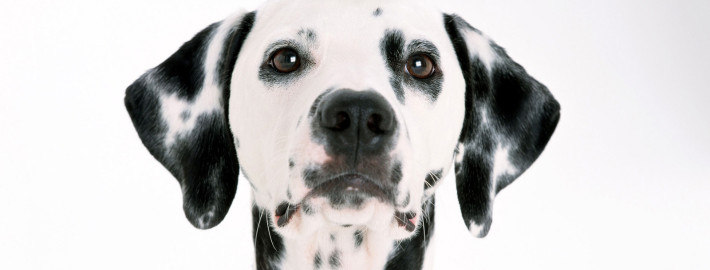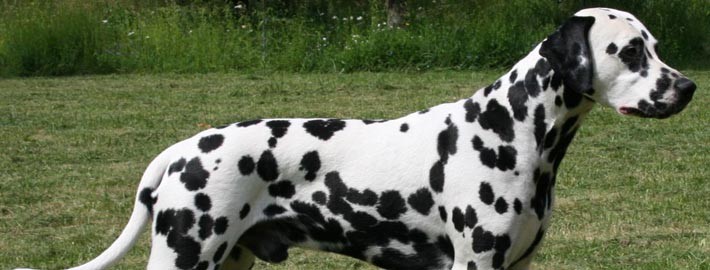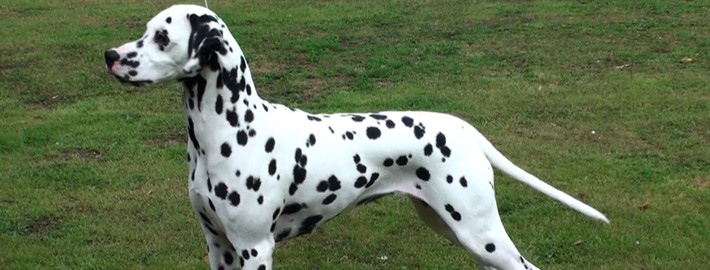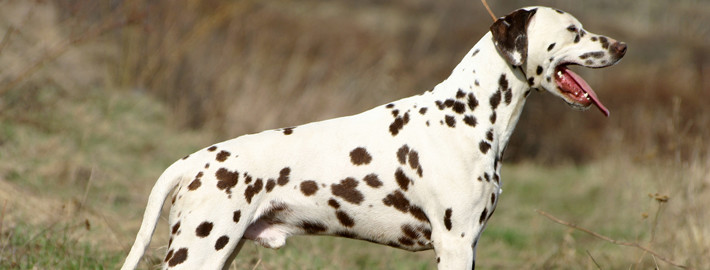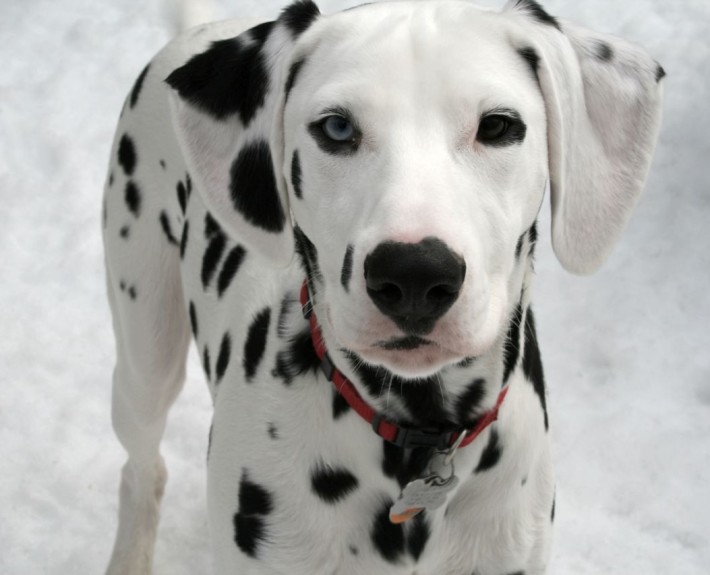What makes the Dalmatian Unique?
The Dalmatian is a square-proportioned, athletic dog of good substance and sturdy bone. It is built for efficiency at the trot and great endurance, and its movement should be steady and effortless. The expression is alert and intelligent; the coat short and sleek. The distinctive spots are an essential point of type; solid patches (distinguished from masses of spots by the patch’s sharply defined, smooth edges) are a disqualification. Bred to run for miles, the Dalmatian retains this tireless enthusiasm. It is a playful, eager companion that must get daily hard exercise in a safe area if it is expected to behave at home. It loves to run and may roam. It may be aggressive toward strange dogs, but it is generally good with other pets and is especially good with horses. It may be too energetic for young children. It tends to be reserved toward strangers. It can be stubborn. Note: Deaf Dalmatians present special training and behavioral problems. They are easily startled and may snap. They are not advised for families with children.
Breed Groups
Page Contents
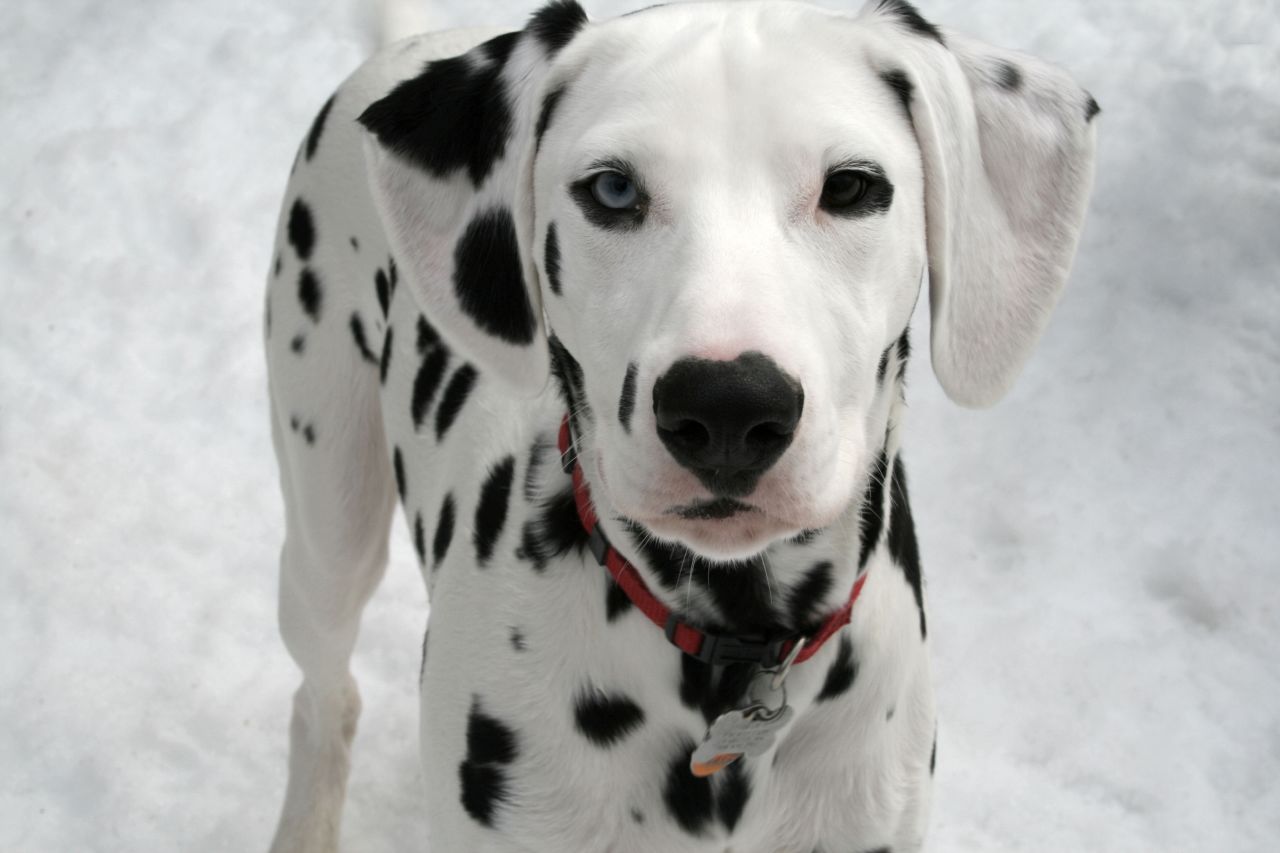
Is the Dalmatian Right For You?
Dalmatian is a square-proportioned, athletic dog of good substance and sturdy bone. It is built for efficiency at the trot and great endurance, and its movement should be steady and effortless. The expression is alert and intelligent; the coat short and sleek.
Bred to run for miles, the Dalmatian retains this tireless enthusiasm. It is a playful, eager companion that must get daily hard exercise in a safe area if it is expected to behave at home. It loves to run and may roam. It may be aggressive toward strange dogs, but it is generally good with other pets and is especially good with horses.
In 5 Words
- Outgoing
- Playful
- Energetic
- Friendly
- Active
Characteristics
Learn About the Dalmatian
Description
The Japanese Akitas are only allowed in the colors of red, white, or brindle. Those dogs with loose skin, a black mask, or too much mass are not acceptable in the show ring because these characteristics generally mean crossbreeding has occurred. In the United States, Canada, Britain, and the rest of the non-FCI regulated areas no difference in type is made and all colors are allowed. The Akita comes in short and long coat varieties, but the latter is considered a fault in the show ring. The long coat only occurs when two carriers of the recessive trait have offspring. Akita females give birth to between 3 and 12 puppies in each litter.
The Japanese dogs are typically smaller and more like foxes in build than their American counterparts are. Male Japanese Akitas measure 64–70 cm. (25 ¼–27 ½ in.) at the withers, or the shoulder blades, and weigh between 70–85 pounds (32–39 kg.). Female Japanese Akitas weight between 50–65 pounds (23–29 kg.) and stand 58–64 cm. (22 ¾–25 ¼ in.) at the withers.
Female American Akitas weigh 80–120 pounds (36–54 kg.) and are 24–26 inches (61–66 cm.) at their withers. By contrast the male American Akita weighs around 100–145 pounds (45–66 kg.) and stands 26–28 inches (66–71 cm.) at the withers.
Short History of the Dalmatian
The Dalmatian is an ancient breed, dating back to 2000BC, when spotted dogs appeared on Greek friezes and tablets, showing them working with the chariots of ancient Greece, Rome and Egypt. Some very early records of the breed are found in Dalmatia, Croatia from whence the name came. Over the years Dalmatians have been used as dogs of war, border patrols, cart pullers, sheep herders, dogs of the hunt, circus performers and, of course, coaching dogs. Whatever the origin, Dalmatians have worked with horses since at least the Middle Ages. During the 17th, 18th, and 19th centuries when the mode of travel was by horse or carriage, Dalmatians were used to protect horses that pulled English stagecoaches. Typically two Dalmatians would run next to the horses as they pulled the coach. When other dogs tried to run out and scare the horses, the Dalmatian team would chase them away.
During this time, horse theft was very common and stage coach drivers used the dogs as guards to protect the team and the luggage in the coach.Additionally, during this era the Dalmatian became a society dog and was trained to run along side women’s carriages. The breed name is among its biggest mysteries. The name was first coined by Thomas Bewick in 1791, but there were no Dalmatian dogs living in Dalmatia when he came up with that name. The first known Dalmatians were imported in 1930 by a ship-owner from England who took his dogs to Dalmatia, a region on the west side of the former Yugoslavia, along the Adriatic Sea, which from 1815 to 1919 was a province of Austria, to live and breed in the place after which they had been named. Dalmatia remains the first proven and accepted home of this breed. The FCI recognized as its country of origin the region of Dalmatia in the Republic of Croatia, citing Bewick’s 1792 work.
Temperament
The Dalmatians will bond very closely with their owner, more so than other breeds and will exhibit separation anxiety when left alone. They are wary of strangers, and males may be aggressive towards other males. Dalmatian puppies are born all white and begin to develop their spots by ten to fourteen days. This is evidence that the spots are actually genetic ticking, as with the Australian Cattle Dog and other breeds that have ticking. Dalmatians are eager, playful and energetic. Potential owners should be aware of the Dalmatians demand for exercise. They can be independent, stubborn and reserved toward strangers.
Dalmatians are extremely people oriented dogs, and will get very lonely if left by themselves, and should be trained to accept their owners’ absence if they must be left alone. A better option is to provide companions. These dogs crave human companionship and do poorly if left alone in a backyard or basement. Dalmatians are famed for their intelligence, independence, and survival instincts. In general they have good memories and kindly natures. Originally bred to defend carriages and horses, these dogs can become territorial if not properly raised. They are extremely loyal to their owners, and can as a result become quite protective of their human families. Because of this protective instinct, some Dalmatians may develop aggression towards other dogs if not properly trained and socialized while young.
Caring for Your Dalmatian
General Health
Hereditary deafness is inherited as a polygenic trait and all Dalmatian bloodlines can pass along deafness to their offspring. Approximately eight percent of Dalmatians are born completely deaf and 22 to 24 percent are born with hearing in one ear only. All puppies are born with their ears closed. The ears should open by 12 to 16 days of age. In Dalmatians, the deafness is characterized by the permanent deterioration by the age of six weeks of the organs of Corti, the nerve cell group inside the cochlea that detect sound. Homemade hearing tests such as stomping on the floor, banging pans together are unreliable because the deaf puppy can feel the vibrations and often learns to adapt very well. The only reliable scientific test is the BAER (Brainstem Auditory Evoked Response). This is not available in all areas but is available at most large specialty practices and teaching hospitals at veterinary schools. It can be done any time after the puppy is five weeks old. Dogs that are used for breeding should have been tested for deafness, and many breeders test puppies before they are sent to their new homes.
Urolithiasis: The Dalmatian has a unique urinary tract system which makes them susceptible to the formation of urinary tract stones (Urolithiasis). The urine of a Dalmatian contains uric acid instead of urea or allantoin. Stones are formed from the salts of the uric acid. Large stones will lodge in the urethra; small stones also called gravel may pass with the urine. If the urinary tract becomes completely blocked and the condition is not treated promptly it will be fatal. Dalmatians must have adequate water at all times and dietary management with food that is not high in purines can be helpful. You can ask your vet to check your dogs’ urine at regular intervals for urate crystals. There is a lot of research being done in this area so new treatment and management protocols are always being developed. Discuss this with your vet.
Skin allergies: Many Dalmatians suffer from skin allergies. There are three main types of allergies: food-based allergies, which are treated by an elimination process of certain foods from the dog’s diet; contact allergies, caused by a reaction to a topical substance such as bedding, flea powders, dog shampoos, and other chemicals, and treated by removing the cause of the allergy; and inhalant allergies, caused by airborne allergens such as pollen, dust, and mildew. The medication for inhalant allergies depends on the severity of the allergy. It is important to note that ear infections often accompany inhalant allergies.
Hip dysplasia: Hip dyplasia is a heritable condition in which the femur doesn’t fit snugly into the pelvic socket of the hip joint. Hip dysplasia can exist with or without clinical signs. Some dogs exhibit pain and lameness on one or both rear legs. As the dog ages, arthritis can develop. X-ray screening for hip dysplasia is done by the Orthopedic Foundation for Animals or the University of Pennsylvania Hip Improvement Program. Dogs with hip dysplasia should not be bred. Ask the breeder for proof that the parents have been tested for hip dysplasia and found to be free of problems.
Iris Sphincter Dysplasia: an inherited ocular disorder that can cause sensitivity to bright light, poor night vision, partial or total blindness, and cataracts. At this point it is not frequently seen in Dalmatians although some studies argue that it is often overlooked. The condition and its treatments are being studied.
Seizures are also present in all breeds. Seizures usually require careful monitoring of medication. A dog that is affected with seizures will need to stay on medication his whole life and should not be bred.
Hypothyroidism seems to be on the rise in all dogs. Some holistic practioners feel it is due to improper diet and overkill with vaccinations. Some signs of hypothyroidism include lethargy, excess shedding, dull coat, overweight, skin problems, reproductive difficulties, etc.
Grooming & Bathing
The Dalmatians are fairly clean dogs that are relatively odorless. However, they shed constantly so regular brushing is necessary to take off all the dead hair. They shed profusely twice a year, usually with the changing from winter to spring and then fall to winter, so during these times, daily brushing is a must. A good brushing with a moderately firm bristle brush once every day or two will put a ;nice gloss on your Dalmatian’s coat and help to alleviate shedding.
Trim his toenails back (just the hooked tip, please!) once a week so they don’t grow too long and cause him discomfort in walking. Check his ears once a week and clean the ear canal with a Q-tip dipped in baby oil If the odor persists or the dog is shaking his head and digging at his ears, have your vet check them for infection or mites. Keep an eye on your Dalmatian’s teeth, too, so that he doesn’t suffer an inordinate built up of tartar.
Exercise & Training
The Dalmatian needs a lot of regular exercise and attention. It needs more than a short walk on leash; it makes a good jogging companion. It can also have its needs met with vigorous games and runs. Although the Dal can live outside in temperate or warm climates, it needs shelter, soft bedding and, most of all, companionship. Thus, it is best allowed to live in the house and play in the yard.

